Popular categories
Looking for a yarn?

100% Cotton
from 1.25 € /50g
Order DROPS Needles & Hooks
Clicking the ORDER button will redirect you to Saules siulas website
The yarn cost is calculated from the pattern’s smallest size and the yarn’s cheapest product type. Looking for an even better price? You might find it on the DROPS Deals!
Echo Mountain
Knitted jumper in DROPS Paris. The piece is worked top down, with round yoke and lace pattern. Sizes S - XXXL.
DROPS Design: Pattern w-862
Yarn group C or A + A
-------------------------------------------------------
SIZES:
S - M - L - XL - XXL - XXXL
MATERIALS:
DROPS PARIS from Garnstudio (belongs to yarn group C)
550-600-650-700-800-850 g colour 100, light wash
NEEDLES:
DROPS CIRCULAR NEEDLE SIZE 5 MM: Length 40 cm and 80 cm.
DROPS CIRCULAR NEEDLE SIZE 3.5 MM: Length 40 cm and 80 cm.
DROPS DOUBLE POINTED NEEDLES SIZE 5 MM.
DROPS DOUBLE POINTED NEEDLES SIZE 3.5 MM.
The technique MAGIC LOOP can be used – you then only need circular needle of 80 cm in each size.
KNITTING TENSION:
17 stitches in width and 22 rows in height with stocking stitch = 10 x 10 cm.
NOTE: Needle size is only a guide. If you get too many stitches on 10 cm, change to a larger needle size. If you get too few stitches on 10 cm, change to a smaller needle size.
-------------------------------------------------------
Alternative Yarn – See how to change yarns here
Yarn Groups A to F – Use the same pattern and change the yarn here
Yarn usage using an alternative yarn – Use our yarn converter here
-------------------------------------------------------

100% Cotton
from 1.25 € /50g
Order DROPS Needles & Hooks
Clicking the ORDER button will redirect you to Saules siulas website
The yarn cost is calculated from the pattern’s smallest size and the yarn’s cheapest product type. Looking for an even better price? You might find it on the DROPS Deals!
- English (UK/cm), Lithuania
- Česky
- Dansk
- Deutsch
- Eesti keel
- English (UK/cm)
- English (US/in)
- Español
- Français
- Íslenska
- Italiano
- Magyar
- Nederlands
- Norsk
- Polski
- Português
- Suomi
- Svenska
- English (UK/cm), Bulgaria
- English (UK/cm), Croatia
- English (UK/cm), Greece
- English (UK/cm), Latvia
- English (UK/cm), Romania
- English (UK/cm), Slovenia
- Česky, Slovakia
Pattern instructions
EXPLANATIONS FOR THE PATTERN:
-------------------------------------------------------
ELEVATION:
To make the jumper slightly higher at the back of the neck, you can work an elevation. Skip this section if you do not want an elevation.
Insert 1 marker at the beginning of the round = mid-back.
Start from the right side, at the marker, and knit 16-17-18-18-19-20, turn, tighten the strand and purl 32-34-36-36-38-40 back.
Turn, tighten the strand and knit 48-51-54-54-57-60, turn, tighten the strand and purl 64-68-72-72-76-80 back.
Turn, tighten the strand and knit 80-85-90-90-95-100, turn, tighten the strand and purl 96-102-108-108-114-120 back.
Turn, tighten the strand and knit to the marker on mid back. Continue the yoke as described in the text.
PATTERN:
See diagrams A.1 and A.2. Choose diagram for your size (applies to A.1).
DECREASE TIP (sleeves):
Decrease 1 stitch on either side of the marker as follows: Work until there are 3 stitches left before the marker, knit 2 together, knit 2 (marker sits between these 2 stitches), slip 1 stitch as if to knit, knit 1 and pass the slipped stitch over the knitted stitch.
-------------------------------------------------------
START THE PIECE HERE:
-------------------------------------------------------
JUMPER – SHORT OVERVIEW OF THE PIECE:
The neck and yoke are worked in the round with circular needle, from mid back and top down. An elevation can be worked at the back of the neck. The yoke is divided for body and sleeves and the body is continued in the round with circular needle. The sleeves are worked with double pointed needles/short circular needle, top down.
NECK:
Cast on 80-84-88-88-92-96 stitches with short circular needle size 3.5 mm and DROPS Paris.
Knit 1 round, then work rib (knit 1 twisted, purl 1) for 4 cm. On the next round increase every other purl-1 to purl-2 by making 1 yarn over after the purled stitch = 100-105-110-110-115-120 stitches.
Continue the new rib – NOTE: On the first round purl the yarn overs twisted to avoid holes.
When the neck measures 5 cm, knit 1 round where you increase 14-15-16-20-23-26 stitches evenly spaced = 114-120-126-130-138-146 stitches.
Change to circular needle size 5 mm.
You can now work an ELEVATION at the back of the neck – read description above.
If you do not want an elevation go straight to YOKE below.
YOKE:
Work stocking stitch for 2-3-3-4-4-5 cm – AT THE SAME TIME on the last round increase 16-20-24-30-32-34 stitches evenly spaced = 130-140-150-160-170-180 stitches. REMEMBER THE KNITTING TENSION!
Now work A.1 a total of 13-14-15-16-17-18 times on the round.
Continue the pattern and increase as shown in the diagram. When A.1 has been completed in height there are 234-252-270-304-323-342 stitches.
Continue with stocking stitch – AT THE SAME TIME on the first round increase 6-12-10-8-5-6 stitches evenly spaced = 240-264-280-312-328-348 stitches.
Work until the piece measures 21-23-25-27-29-31 cm from the cast-on edge.
Now divide for the body and sleeves as follows: Knit 36-40-42-46-50-54 (½ back piece), place the next 48-52-56-64-64-66 stitches on a thread for the sleeve, cast on 6-6-8-8-10-12 stitches (in side under sleeve), knit 72-80-84-92-100-108 (front piece), place the next 48-52-56-64-64-66 stitches on a thread for the sleeve, cast on 6-6-8-8-10-12 stitches (in side under sleeve), knit the last 36-40-42-46-50-54 stitches (½ back piece).
The body and sleeves are finished separately. THE PIECE IS NOW MEASURED FROM HERE!
BODY:
= 156-172-184-200-220-240 stitches. Work stocking stitch until the body measures 22 cm from the division. Knit 1 round where you increase 36-40-42-46-50-56 stitches evenly spaced = 192-212-226-246-270-296 stitches. Change to circular needle size 3.5 mm and work rib (knit 1 twisted, purl 1) for 5 cm. Cast off with knit, a little loosely. The jumper measures approx. 52-54-56-58-60-62 cm from the shoulder down.
SLEEVES:
Place the 48-52-56-64-64-66 stitches from the thread on the one side of the piece on short circular needle/double pointed needles size 5 mm and knit up 1 stitch in each of the 6-6-8-8-10-12 stitches cast on under the sleeve = 54-58-64-72-74-78 stitches. Insert a marker in the middle of the 6-6-8-8-10-12 stitches under the sleeve. Allow the marker to follow your work onwards; it will be used when decreasing under the sleeve.
Start at the marker and work stocking stitch in the round. When the sleeve measures 3-3-2-2-2-2, decrease 2 stitches under the sleeve – read DECREASE TIP. Decrease like this every 4-3-2-2-1½-1½ cm a total of 3-5-8-8-9-11 times = 48-48-48-56-56-56 stitches. Continue working until the sleeve measures 32-30-29-28-26-25 cm from the division. There is approx. 12 cm left to finished length. Try the jumper on and work to desired length.
Work A.2 a total of 6-6-6-7-7-7 times on the round. When A.2 is finished, change to double pointed needles size 3.5 mm and continue the rib (knit 1 twisted, purl 1) – AT THE SAME TIME on the first round increase every other purl-1 to purl-2 = 60-60-60-70-70-70 stitches.
Work until the sleeve measures 44-42-41-40-38-37 cm. Cast off with knit, a little loosely.
Work the other sleeve in the same way.
Diagram

|
= knit |

|
= knit twisted |

|
= purl |

|
= between 2 stitches make 1 yarn over; on the next round knit the yarn over to leave a hole |

|
= between 2 stitches make 1 yarn over; on the next round knit the yarn over twisted to avoid a hole |

|
= slip 1 stitch as if to knit-twisted, knit 1 twisted and pass the slipped stitch over the knitted stitch |

|
= slip 1 stitch as if to knit, slip the next stitch and place it twisted back onto the left needle, place the first slipped stitch twisted back onto the left needle and knit these 2 stitches together |

|
= slip 1 stitch as if to knit-twisted, knit 2 twisted together and pass the slipped stitch over the knitted together stitches |

|
= move the beginning of the round 1 stitch to the right (applies only to this round) |

|
= this stitch doesn't exist beacuse the beginning of the round has been displaced |
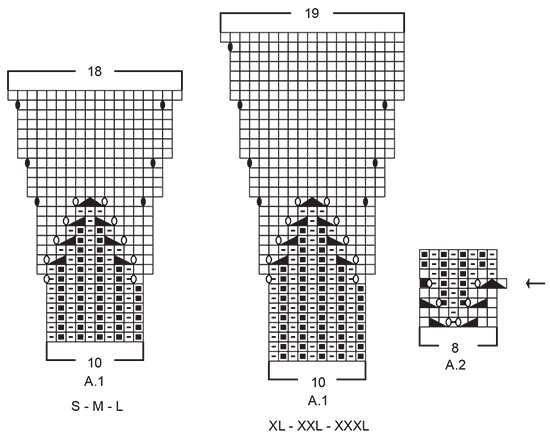
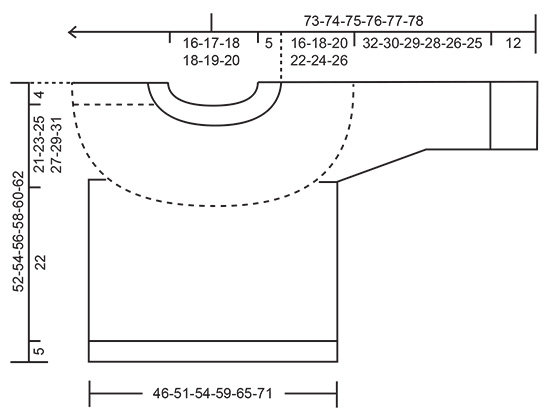
What can you do with our patterns? You can share DROPS patterns online, using the pattern original picture, materials, name and number. But you are NOT ALLOWED to reproduce the complete pattern digitally in any way. Yarn stores are welcome to use the DROPS pattern database to promote the sale of our assortment. You can print out our patterns, make as many copies as you’d like. The only thing we ask is that you don't make any changes / additions to the original printed document. And that the patterns according to the DROPS philosophy are given out to the consumers for free. Editorials that wish to publish our patterns in printed books or magazines can contact us for more information. The sale of garments based on DROPS patterns is permitted as long as they are sold as single items or per order. Further commercial use of the patterns is not permitted. It has to be clearly stated that the garment is made based on a design from DROPS DESIGN. The use of clothing labels of which DROPS DESIGN forms part is conditioned by the inclusion of the following text: “A DROPS DESIGN made by …..”. The use of DROPS photos for marketing purposes/sales is only permitted in connection with the use/sale of DROPS products. The photos may not be cut or edited and the logo should be clearly visible.
We reserve the right to withdraw the permission for use of our patterns at any time, notwithstanding the reason.
Each of our patterns has specific tutorial videos to help you.
These step-by-step tutorials might also help you:
Why is the knitting/crochet tension so important?
Knitting tension is what determines the final measurements of your work, and is usually measured per 10 x 10 cm. It is provided like so: number of stitches in width x number of rows in height - eg: 19 stitches x 26 rows = 10 x 10 cm.
The knitting tension is very individual; some people knit/crochet loosely while others work tightly. You adjust the knitting tension with the needle size, which is why the suggested needle size is only meant as a guide! You need to adjust this (up or down) to ensure that YOUR knitting tension matches the knitting tension provided in the pattern. If you work with a different knitting tension than provided you will have a different yarn consumption, and your work will have different measurements than what the pattern suggests.
The knitting tension also determines which yarns can replace each other. As long as you achieve the same knitting tension you can replace one yarn with another.
See DROPS lesson: How to measure your tension/gauge
See DROPS video: How to make a gauge tension swatch
How do I know how many balls of yarn I need?
The required amount of yarn is provided in grams, eg: 450 g. To calculate how many balls you’ll need you first need to know how many grams are in 1 ball (25g, 50g or 100g). This information is available if you click on the individual yarn quality on our pages. Divide the amount required with the amount of each ball. For example, if each ball is 50g (the most common amount), the calculation will be as follows: 450 / 50 = 9 balls.
Can I use a different yarn than what the pattern suggests?
The important thing when changing from one yarn to another is that the knitting/crochet tension remains the same. This is so that the measurements of the finished piece will be the same as on the sketch provided. It is easier to achieve the same knitting tension using yarns from the same yarn group. It is also possible to work with multiple strands of a thinner yarn to achieve the knitting tension of a thicker one. Please try our yarn converter. We recommend you to always work a test swatch.
Please NOTE: when changing yarn the garment might have a different look and feel to the garment in the photo, due to individual properties and qualities of each yarn.
See DROPS lesson: Can I use a different yarn than the one mentioned in the pattern?
What are the yarn groups?
All our yarns are categorised into yarn groups (from A to F) according to thickness and knitting tension – group A contains the thinnest yarns and group F the thickest. This makes it easier for you to find alternative yarns to our patterns, should you wish to switch yarn. All yarns within the same group have a similar knitting tension and can easily replace each other. However, different yarn qualities have different structures and properties which will give the finished work a unique look and feel.
How do I use the yarn calculator?
At the top of all our patterns you’ll find a link to our yarn calculator, which is a helpful tool should you wish to use a different yarn than suggested. By filling in the yarn quality you wish to replace, the amount (in your size) and number of strands, the calculator will present good alternative yarns with the same knitting tension. Additionally it will tell you how much you’ll require in the new qualities and whether you’ll need to work with multiple strands. Most skeins are 50g (some are 25g or 100g).
If the pattern is worked with multiple colours, every colour will have to be calculated separately. Similarly, if the pattern is worked with several strands of different yarns (for example 1 strand Alpaca and 1 strand Kid-Silk) you will have to find alternatives for each, individually.
Why do you show discontinued yarns in the patterns?
Since different yarns have different qualities and textures we have chosen to keep the original yarn in our patterns. However, you can easily find options among our available qualities by using our yarn calculator, or simply pick a yarn from the same yarn group.
It is possible that some retailers still have discontinued yarns in stock, or that someone has a few skeins at home that they would like to find patterns for.
The yarn calculator will provide both alternative yarn as well as required amount in the new quality.
What size should I knit?
If you think it's hard to decide what size to make, it can be a good idea to measure a garment you own already and like the size of. Then you can pick the size by comparing those measures with the ones available in the pattern's size chart.
You'll find the size chart at the bottom of the pattern.
See DROPS lesson: How to read size chart
Why do I get the wrong knitting tension with the suggested needle size?
The needle size provided in the pattern serves only as a guide, the important thing is to follow the knitting tension. And since knitting tension is very individual, you will have to adjust the needle size to ensure that YOUR tension is the same as in the pattern – maybe you’ll have to adjust 1, or even 2 needle sizes, up or down to achieve the correct tension. For this, we recommend that you work test swatches.
Should you work with a different knitting tension than the one provided, the measurements of the finished garment might deviate from the measurement sketch.
See DROPS lesson: How to measure your tension/gauge
See DROPS video: How to make a tension/gauge swatch
Why is the pattern worked top-down?
Working a garment top-down provides more flexibility and room for personal adjustment. For example it is easier to try the garment on while working, as well as making adjustments to length of yoke and shoulder caps.
The instructions are carefully explaining every step, in the correct order. Diagrams are adjusted to the knitting direction and are worked as usual.
How do I work according to a knitting diagram?
The diagram depicts all rows/rounds, and every stitch seen from the right side. It is read from bottom to top, from right to left. 1 square = 1 stitch.
When working back and forth, every other row is worked from the right side and every other row is worked from the wrong side. When working from the wrong side, the diagram will have to be worked reversed: from left to right, knit stitches are purled, purl stitches are knit etc.
When working in the round every round is worked from the right side and the diagram are worked from right to left on all rounds.
See DROPS lesson: How to read knitting diagrams
How do I work according to a crochet diagram?
The diagram depicts all rows/rounds, and every stitch seen from the right side. It is worked from bottom to top, from right to left.
When working back and forth every other row is worked from the right side: from right to left and every other row is worked from the wrong side: from left to right.
When working in the round, every row in the diagram are worked from the right side, from right to left.
When working a circular diagram you start in the middle and work your way outwards, counter clockwise, row by row.
The rows usually start with a given number of chain stitches (equivalent to the height of the following stitch), this will either be depicted in the diagram or explained in the pattern.
See DROPS lesson: How to read crochet diagrams
How do I work several diagrams simultaneously on the same row/round?
Instructions for working several diagrams after each other on the same row/round, will often be written like so: “work A.1, A.2, A.3 a total of 0-0-2-3-4 times". This means you work A.1 once, then A.2 is worked once, and A.3 is repeated (in width) the number of times provided for your size – in this case like so: S = 0 times, M = 0 times, L=2 times, XL= 3 times and XXL = 4 times.
The diagrams are worked as usual: begin with the first row in A.1, then work the first row in A.2 etc.
See DROPS lesson: How to read knitting diagrams
See DROPS lesson: How to read crochet diagrams
Why are the sleeves shorter in larger sizes?
The total width of the garment (from wrist-to-wrist) will be larger in the larger sizes, despite the actual sleeves being shorter. The larger sizes have longer sleeve caps and wider shoulders, so there will be a good fit in all sizes.
Where on the garment is the length measured?
The measurement sketch/schematic drawing provides information regarding the full length of the garment. If it’s a jumper or a jacket the length is measured from the highest point on the shoulder closest to the neckline, and straight down to the bottom of the garment. It is NOT measured from the tip of shoulder. Similarly, the length of yoke is measured from the highest point on the shoulder and down to where yoke is split into body and sleeves.
On a jacket measures are never taken along bands, unless specifically stated. Always measure inside band stitches when measuring the length.
See DROPS lesson: How to read a schematic drawing
What is a repeat?
Diagrams are often repeated on the round or in height. 1 repeat is the diagram the way it appears in the pattern. If it says to work 5 repeats of A.1 in the round, then you work A.1 a total of 5 times after/next to each other in the round. If it says to work 2 repeats of A.1 vertically/in height you work the entire diagram once, then begin again at the start and work the entire diagram one more time.
Why does the piece start with more chain stitches than it’s worked with?
Chain stitches are slightly narrower than other stitches and to avoid working the cast-on edge too tight, we simply chain more stitches to begin with. The stitch count will be adjusted on the following row to fit the pattern and measurement sketch.
Why increase before the rib edge when the piece is worked top-down?
The rib edge is more elastic and will contract slightly compared to, for example, stocking stitch. By increasing before the rib edge, you avoid a visible difference in width between the rib edge and the rest of the body.
Why increase in the cast-off edge?
It’s very easy to cast off too tightly, and by making yarn overs while casting off (and simultaneously casting these off) you avoid a too tight cast off edge.
See DROPS video: How to bind off with yarn overs (yo)
How do I increase/decrease on every 3rd and 4th row/round alternately?
To achieve an even increase (or decrease) you can increase on, for example: every 3rd and 4th row alternately, like so: work 2 rows and increase on the 3rd row, work 3 rows and increase on the 4th. Repeat this until the increase is complete.
See DROPS lesson: Increase or decrease 1 st on every 3rd and 4th row alternately
How can I work a jacket in the round instead of back and forth?
Should you prefer to work in the round instead of back and forth, you may of course adjust the pattern. You’ll need to add steeks mid-front (usually 5 stitches), and follow the instructions. When you would normally turn and work from the wrong side, simply work across the steek and continue in the round. At the end you’ll cut the piece open, pick up stitches to work bands, and cover the cut edges.
See DROPS video: How to knit steeks and cut open
Can I work a jumper back and forth instead of in the round?
Should you prefer to work back and forth instead of in the round, you may of course adjust the pattern so you work the pieces separately and then assemble them at the end. Divide the stitches for the body in 2, add 1 edge stitch in each side (for sewing) and work the front and back pieces separately.
See DROPS lesson: Can I adapt a pattern for circular needles into straight needles?
Why is the pattern slightly different than what I see in the photo?
Pattern repeats can vary slightly in the different sizes, in order to get the correct proportions. If you’re not working the exact same size as the garment in the photo, yours might deviate slightly. This has been carefully developed and adjusted so that the complete impression of the garment is the same in all sizes.
Make sure to follow instructions and diagrams for your size!
How do I make a women’s size garment into a men’s size one?
If you have found a pattern you like which is available in women’s size it’s not very difficult to convert it to men’s size. The biggest difference will be the length of sleeves and body. Start working on the women size that you think would fit across the chest. The additional length will be worked right before you cast off for the armhole/sleeve cap. If the pattern is worked top-down you can add the length right after the armhole or before the first decrease on sleeve.
Regarding additional yarn amount, this will depend on how much length you add, but it is better with a skein too many than too few.
How do I prevent a hairy garment from shedding?
All yarns will have excess fibres (from production) that might come off as lint or shedding. Brushed yarns (ie hairier yarns) have more of these loose, excess fibres, causing more shedding.
Shedding also depends on what is worn under or over the garment, and whether this pulls at the yarn fibres. It’s therefore not possible to guarantee that there will be no shedding
Below are some tips on how to get the best result when working with hairier yarns:
1. When the garment is finished (before you wash it) shake it vigorously so the looser hairs come off. NOTE: do NOT use a lint roller, brush or any method that pulls at the yarn.
2. Place the garment in a plastic bag and put it in your freezer - the temperature will cause the fibres to become less attached to each other, and excess fibres will come off easier.
3. Leave in the freezer for a few hours before taking it out and shaking it again.
4. Wash the garment according to the instructions on the yarn label.
Why does my garment pill?
Pilling is a natural process that happens to even the most exclusive of fibers. It's a natural sign of wear and tear that is hard to avoid, and that is most visible in high friction areas of your garment like a sweater's arms and cuffs.
You can make your garment look as new by removing the pilling, using a fabric comb or a pill/lint remover.
In the meantime, you can read the questions and answers that others have left to this pattern or join the DROPS Workshop on Facebook to get help from fellow knitters/crocheters!
You might also like...
Echo Mountain |
|||||||||||||||||||||||||||||||
 |
 |
||||||||||||||||||||||||||||||
Knitted jumper in DROPS Paris. The piece is worked top down, with round yoke and lace pattern. Sizes S - XXXL.
DROPS 230-18 |
|||||||||||||||||||||||||||||||
|
------------------------------------------------------- EXPLANATIONS FOR THE PATTERN: ------------------------------------------------------- ELEVATION: To make the jumper slightly higher at the back of the neck, you can work an elevation. Skip this section if you do not want an elevation. Insert 1 marker at the beginning of the round = mid-back. Start from the right side, at the marker, and knit 16-17-18-18-19-20, turn, tighten the strand and purl 32-34-36-36-38-40 back. Turn, tighten the strand and knit 48-51-54-54-57-60, turn, tighten the strand and purl 64-68-72-72-76-80 back. Turn, tighten the strand and knit 80-85-90-90-95-100, turn, tighten the strand and purl 96-102-108-108-114-120 back. Turn, tighten the strand and knit to the marker on mid back. Continue the yoke as described in the text. PATTERN: See diagrams A.1 and A.2. Choose diagram for your size (applies to A.1). DECREASE TIP (sleeves): Decrease 1 stitch on either side of the marker as follows: Work until there are 3 stitches left before the marker, knit 2 together, knit 2 (marker sits between these 2 stitches), slip 1 stitch as if to knit, knit 1 and pass the slipped stitch over the knitted stitch. ------------------------------------------------------- START THE PIECE HERE: ------------------------------------------------------- JUMPER – SHORT OVERVIEW OF THE PIECE: The neck and yoke are worked in the round with circular needle, from mid back and top down. An elevation can be worked at the back of the neck. The yoke is divided for body and sleeves and the body is continued in the round with circular needle. The sleeves are worked with double pointed needles/short circular needle, top down. NECK: Cast on 80-84-88-88-92-96 stitches with short circular needle size 3.5 mm and DROPS Paris. Knit 1 round, then work rib (knit 1 twisted, purl 1) for 4 cm. On the next round increase every other purl-1 to purl-2 by making 1 yarn over after the purled stitch = 100-105-110-110-115-120 stitches. Continue the new rib – NOTE: On the first round purl the yarn overs twisted to avoid holes. When the neck measures 5 cm, knit 1 round where you increase 14-15-16-20-23-26 stitches evenly spaced = 114-120-126-130-138-146 stitches. Change to circular needle size 5 mm. You can now work an ELEVATION at the back of the neck – read description above. If you do not want an elevation go straight to YOKE below. YOKE: Work stocking stitch for 2-3-3-4-4-5 cm – AT THE SAME TIME on the last round increase 16-20-24-30-32-34 stitches evenly spaced = 130-140-150-160-170-180 stitches. REMEMBER THE KNITTING TENSION! Now work A.1 a total of 13-14-15-16-17-18 times on the round. Continue the pattern and increase as shown in the diagram. When A.1 has been completed in height there are 234-252-270-304-323-342 stitches. Continue with stocking stitch – AT THE SAME TIME on the first round increase 6-12-10-8-5-6 stitches evenly spaced = 240-264-280-312-328-348 stitches. Work until the piece measures 21-23-25-27-29-31 cm from the cast-on edge. Now divide for the body and sleeves as follows: Knit 36-40-42-46-50-54 (½ back piece), place the next 48-52-56-64-64-66 stitches on a thread for the sleeve, cast on 6-6-8-8-10-12 stitches (in side under sleeve), knit 72-80-84-92-100-108 (front piece), place the next 48-52-56-64-64-66 stitches on a thread for the sleeve, cast on 6-6-8-8-10-12 stitches (in side under sleeve), knit the last 36-40-42-46-50-54 stitches (½ back piece). The body and sleeves are finished separately. THE PIECE IS NOW MEASURED FROM HERE! BODY: = 156-172-184-200-220-240 stitches. Work stocking stitch until the body measures 22 cm from the division. Knit 1 round where you increase 36-40-42-46-50-56 stitches evenly spaced = 192-212-226-246-270-296 stitches. Change to circular needle size 3.5 mm and work rib (knit 1 twisted, purl 1) for 5 cm. Cast off with knit, a little loosely. The jumper measures approx. 52-54-56-58-60-62 cm from the shoulder down. SLEEVES: Place the 48-52-56-64-64-66 stitches from the thread on the one side of the piece on short circular needle/double pointed needles size 5 mm and knit up 1 stitch in each of the 6-6-8-8-10-12 stitches cast on under the sleeve = 54-58-64-72-74-78 stitches. Insert a marker in the middle of the 6-6-8-8-10-12 stitches under the sleeve. Allow the marker to follow your work onwards; it will be used when decreasing under the sleeve. Start at the marker and work stocking stitch in the round. When the sleeve measures 3-3-2-2-2-2, decrease 2 stitches under the sleeve – read DECREASE TIP. Decrease like this every 4-3-2-2-1½-1½ cm a total of 3-5-8-8-9-11 times = 48-48-48-56-56-56 stitches. Continue working until the sleeve measures 32-30-29-28-26-25 cm from the division. There is approx. 12 cm left to finished length. Try the jumper on and work to desired length. Work A.2 a total of 6-6-6-7-7-7 times on the round. When A.2 is finished, change to double pointed needles size 3.5 mm and continue the rib (knit 1 twisted, purl 1) – AT THE SAME TIME on the first round increase every other purl-1 to purl-2 = 60-60-60-70-70-70 stitches. Work until the sleeve measures 44-42-41-40-38-37 cm. Cast off with knit, a little loosely. Work the other sleeve in the same way. |
|||||||||||||||||||||||||||||||
Diagram explanations |
|||||||||||||||||||||||||||||||
|
|||||||||||||||||||||||||||||||

|
|||||||||||||||||||||||||||||||

|
|||||||||||||||||||||||||||||||
|
Have you made this or any other of our designs? Tag your pictures in social media with #dropsdesign so we can see them! Do you need help with this pattern?You'll find tutorial videos, a Comments/Questions area and more by visiting the pattern on garnstudio.com. © 1982-2024 DROPS Design A/S. We reserve all rights. This document, including all its sub-sections, has copyrights. Read more about what you can do with our patterns at the bottom of each pattern on our site. |
|||||||||||||||||||||||||||||||
With over 40 years in knitting and crochet design, DROPS Design offers one of the most extensive collections of free patterns on the internet - translated to 17 languages. As of today we count 304 catalogues and 11422 patterns - 11422 of which are translated into English (UK/cm).
We work hard to bring you the best knitting and crochet have to offer, inspiration and advice as well as great quality yarns at incredible prices! Would you like to use our patterns for other than personal use? You can read what you are allowed to do in the Copyright text at the bottom of all our patterns. Happy crafting!






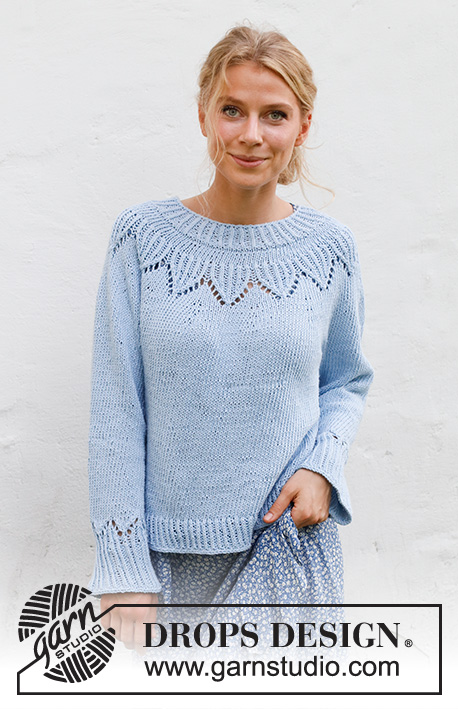

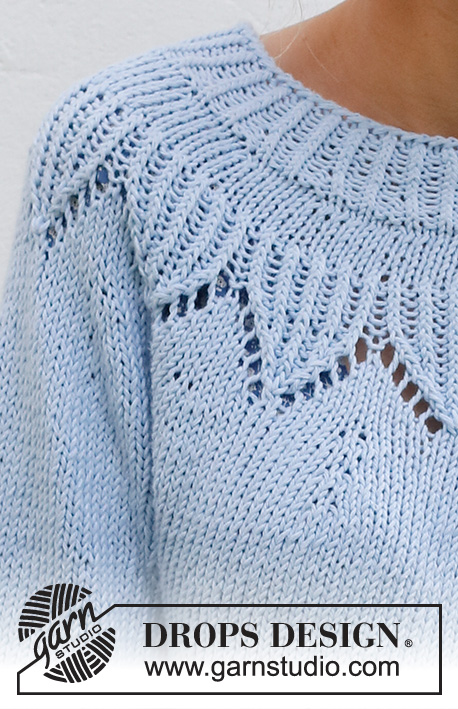


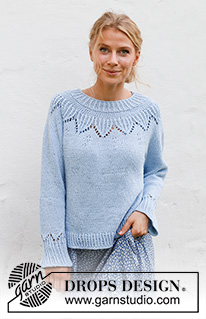
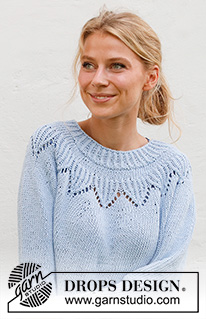

























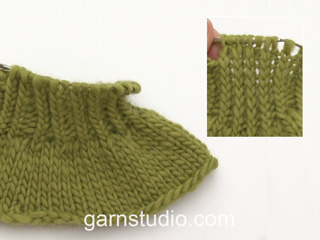
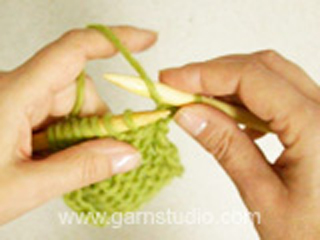





























Comments / Questions (18)
W opisie rekawa przy przejsciu na sciagacz trzeba dodac oczko w co 2 oczko lewe, czy to oznacza ze sciagacz nie bedzie jeden na jeden tylko 1 op, 1 ol , 1 op I 2 ol?Bo wczoraj A2 juz konczy sie sciagaczem 1 na 1
01.02.2024 - 12:10DROPS Design answered:
Witaj Agnieszko, po dodaniu 1 oczka w co drugie oczko lewe, ściągacz będzie wyglądał następująco: 1 op przekręcone, 1 ol , 1 op przekręcone, 2 ol, itd. Zobacz na zdjęciu gdzie jest widoczny mankiet rękawa. Pozdrawiamy!
03.02.2024 - 08:04Buongiorno. Vorrei solo una conferma: è esatto che per il bordo si usano i ferri 3.50? Ho paura che, soprattutto il collo, venga troppo stretto.\r\nGrazie
04.08.2023 - 18:54DROPS Design answered:
Buonasera AnnaLisa, se il suo campione corrisponde a quello riportato, sì, deve lavorare il bordo con i ferri mm. Buon lavoro!
04.08.2023 - 19:52Hvor står garnmengden som trengs ?
30.04.2023 - 13:21DROPS Design answered:
Hei Gro. Den står øverst i oppskriften, nære bildet. MATERIALER: DROPS PARIS fra Garnstudio (tilhører garngruppe C) 550-600-650-700-800-850 g farge 100, light wash. mbh DROPS Design
02.05.2023 - 13:21Waarom een model van boven naar onder breien vraag ik me af. Ik vind dit niet zo handig zekers als je aanpassingen moet doen in een ajour of kantpatroon. Dan klopt je telpatroon niet meer heb ik onder vonden. Is er misschien een manier om dat nog wel te laten kloppen, en is het mogelijk om zo een model ook op de klassieke manier te maken????? Dus van onder naar boven, want dan kan je het verschil vaak opvangen in het jersey gedeelte.
14.02.2023 - 09:39Dobrý den, prosím není mi jasné, sejmeme 1 oko hladce,sejmeme další oko a vrátíme je na levou jehlici, první sejmuté oko vrátíme na levou jehlici a tato dvě oka spleteme hladce dohromady. Mohu ty 2 oka prostě splest hladce. Děkuji za odpověď. Jana Bočková
20.09.2022 - 19:50DROPS Design answered:
Dobrý den Jani, obě oka vrátíte na levou jehlici přetočená a potom je spletete hladce. Při překladu návodu se nám ztratila slovíčka. Děkuji za upozornění, popis symbolu je opraven. Přeji hodně zdaru při pletení.
20.09.2022 - 20:13How can I knit this pattern with straight needles?
02.08.2022 - 11:03DROPS Design answered:
Dear Mrs Gadkari, this lesson explains how to adapt a pattern into straight needles, it might be sometimes easier to work in the round, see our lesson or our video showing how to work a jumper top down, they might help you. Happy knitting!
02.08.2022 - 11:46Zet 6 steken op (in de zijkant onder de mouw) ik begrijp niet wat ze daar mee bedoelen, is het mogelijk om een beetje uitlag
17.05.2022 - 18:27DROPS Design answered:
Dag Sonia,
In de video over hoe je een trui van boven naar beneden breit is dit uitgelegd op ongeveer
19.05.2022 - 20:43Hallo, welche Größe ist xxl ?
25.04.2022 - 07:21DROPS Design answered:
Liebe Andy, messen Sie einen ähnlichen Pullover, den Sie gern haben und vergleichen Sie diese Maßen mit den in der Maßskizze. So finden Sie die passenden Größe. Hier lesen Sie mehr. Viel Spaß beim stricken!
25.04.2022 - 08:37Wanneer is deze mooie trui beschikbaar? kan niet wachten hihi
11.03.2022 - 08:57Kronblad-genser. Eller Petalsweater
01.02.2022 - 17:22